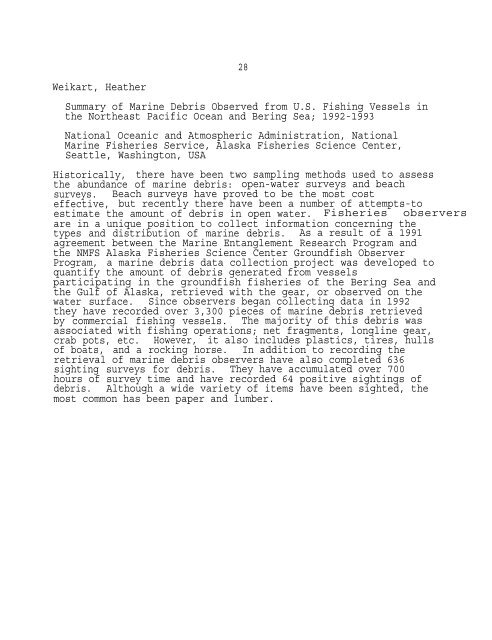Poster abstracts and manuscripts from the Third International ...
Poster abstracts and manuscripts from the Third International ...
Poster abstracts and manuscripts from the Third International ...
You also want an ePaper? Increase the reach of your titles
YUMPU automatically turns print PDFs into web optimized ePapers that Google loves.
Weikart, Hea<strong>the</strong>r<br />
28<br />
Summary of Marine Debris Observed <strong>from</strong> U.S. Fishing Vessels in<br />
<strong>the</strong> Nor<strong>the</strong>ast Pacific Ocean <strong>and</strong> Bering Sea; 1992-1993<br />
National Oceanic <strong>and</strong> Atmospheric Administration, National<br />
Marine Fisheries Service, Alaska Fisheries Science Center,<br />
Seattle, Washington, USA<br />
Historically, <strong>the</strong>re have been two sampling methods used to assess<br />
<strong>the</strong> abundance of marine debris: open-water surveys <strong>and</strong> beach<br />
surveys. Beach surveys have proved to be <strong>the</strong> most cost<br />
effective, but recently <strong>the</strong>re have been a number of attempts-to<br />
estimate <strong>the</strong> amount of debris in open water. Fisheries observers<br />
are in a unique position to collect information concerning <strong>the</strong><br />
types <strong>and</strong> distribution of marine debris. As a result of a 1991<br />
agreement between <strong>the</strong> Marine Entanglement Research Program <strong>and</strong><br />
<strong>the</strong> NMFS Alaska Fisheries Science Center Groundfish Observer<br />
Program, a marine debris data collection project was developed to<br />
quantify <strong>the</strong> amount of debris generated <strong>from</strong> vessels<br />
participating in <strong>the</strong> groundfish fisheries of <strong>the</strong> Bering Sea <strong>and</strong><br />
<strong>the</strong> Gulf of Alaska, retrieved with <strong>the</strong> gear, or observed on <strong>the</strong><br />
water surface. Since observers began collecting data in 1992<br />
<strong>the</strong>y have recorded over 3,300 pieces of marine debris retrieved<br />
by commercial fishing vessels. The majority of this debris was<br />
associated with fishing operations; net fragments, longline gear,<br />
crab pots, etc. However, it also includes plastics, tires, hulls<br />
of boats, <strong>and</strong> a rocking horse. In addition to recording <strong>the</strong><br />
retrieval of marine debris observers have also completed 636<br />
sighting surveys for debris. They have accumulated over 700<br />
hours of survey time <strong>and</strong> have recorded 64 positive sightings of<br />
debris. Although a wide variety of items have been sighted, <strong>the</strong><br />
most common has been paper <strong>and</strong> lumber.
















